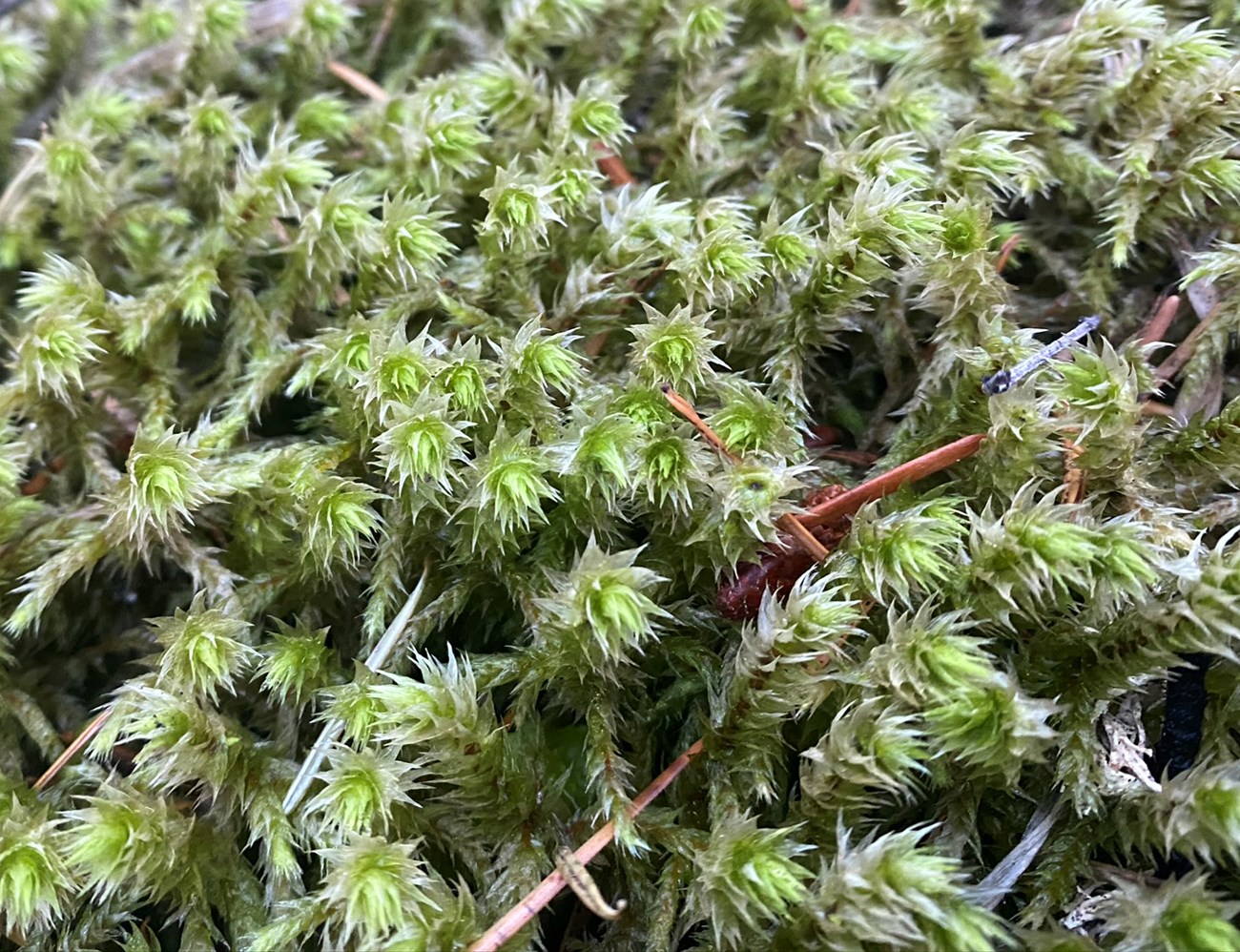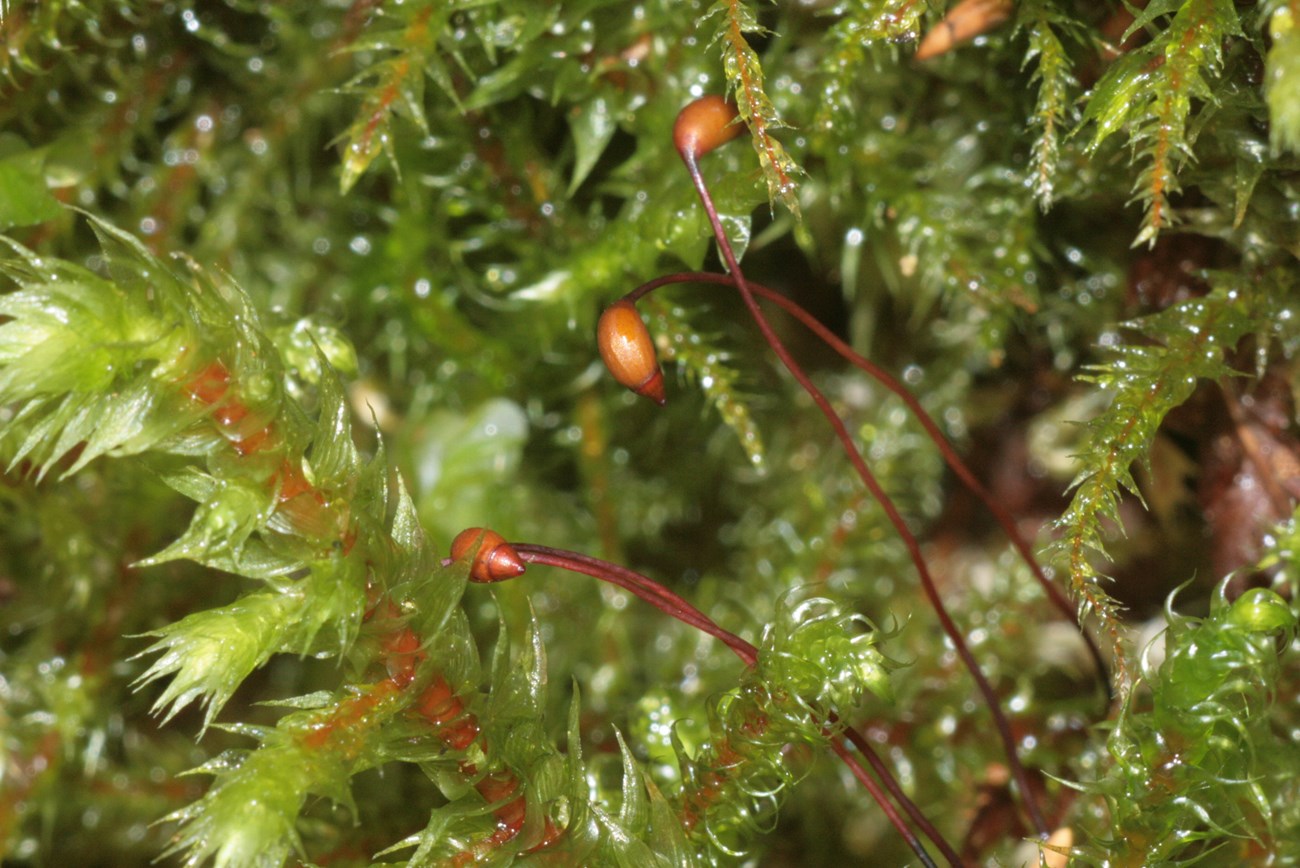Last updated: January 19, 2021
Article
Electrified Cat's Tail Moss

Jason Brooks
General Description
You might think the forest floor hid secret electric outlets if you came upon a clump of Rhytidiadelphus triquetrus, also known as electrified cat’s tail moss. This folk name arises from the bristly “leaves” growing straight out in all directions from its reddish stem. Electrified cat’s tail moss matures into a greenish-yellow cluster, or loose mat, of interwoven growth (not true stems or leaves) stretching up to 15 cm long on the forest floor, in moist habitats.
Like all mosses, the electrified cat’s tail is a bryophyte, one of the two major green land plant groups in the plant kingdom. Bryophytes are nonvascular plants, meaning they lack a hardened structure within which water and food can be efficiently transported throughout their bodies. Hornworts and liverworts join mosses in the division Bryophyta. Though they are land dwellers, bryophytes depend on external water for reproduction, tying most species, though not all, to wet areas. The other major group is vascular green land plants—division Tracheophyta. Vascular plants grow in a much wider range of habitats and comprise a much greater variety of species, including ferns, flowering plants, and conifers. Vascular plants contain hardened vesicles that store and distribute food and water through xylem and phloem tissues much more effectively. This makes them less reliant on external moisture for vital processes like reproduction and photosynthesis.
The “stem” and “leaves” and “roots” of the electrified cat’s tail are primitive versions of the more newly evolved vascular plant structures. In most mosses, a thin layer of dead cells allows some water movement, via hydroid cells, and nutrient movement, via leptoid cells, through the body. These channels, however, are not hardened or lignified, as with vascular plants. The “leaves” can be quite specialized among different moss species, but are typically one cell thick, growing in a spiral around the “stem.” They produce energy for the plant through photosynthesis. Some cells form rhizoids, a primitive form of “roots” that anchor the moss to its substrate.
Habitat and Distribution
The electrified cat’s tail moss grows in moist montane forests across the boreal landscape of the northern hemisphere, southward down into the southern Appalachian region of eastern United States as well as into the Pacific Northwest. It’s often found growing in humus, litter, and on rotten logs in southern Oregon and northern California.
Ecology
Though mosses are more abundant in permanently moist habitats, some occupy arid places, even deserts, where they can’t avoid drying up with their surroundings. They survive by entering a period of dormancy that ends abruptly without damaging the moss when moisture returns, showing a remarkable desiccation tolerance.
Mosses are not high-quality food for animals, but they serve other ecological roles. They colonize barren ground, enriching and moisturizing the soil with the organic remains of each new generation. Birds and mammals also incorporate moss into their nests, including the rare marbled murrelet (Brachyramphus marmoratus).

Hermann Schachner, Creative Commons CC0 1.0 License
Reproduction
Like all plants, mosses alternate between two different forms from one generation to the next. The dominant form is the gametophyte, which is the main, visually obvious green body of a moss. Each gametophyte generates either sperm or egg cells for sexual reproduction. The sperm from a male gametophyte must travel through water to reach the nearby female gametophyte’s egg, which is one reason mosses prefer moist habitats. The fertilized egg grows into the form taken by the next generation—the sporophyte: a slender stem growing straight out of the gametophyte with a capsule on its tip that eventually releases microscopic spores. Upon landing on a suitable substrate, the spore grows into a small mat of flattened alga-like filaments, called a protonema. The protonema matures into either male or female gametophytes, with distinct “stems” and “leaves,” to continue the life cycle. Curiously, in mosses the larger gametophyte nurtures the smaller sporophyte, whereas the opposite is true in vascular plants, where the dominant sporophyte (the tree, the shrub) nurtures the tiny gametophyte (pollen grain or ovule).
Where to See
Electrified cat’s tail moss grows in Redwood National and State Parks, Oregon Caves National Monument and Preserve, and possibly Whiskeytown National Recreation Area.
Learn More
https://ucjeps.berkeley.edu/cgi-bin/get_moss_treatment.pl?taxon=Rhytidiadelphus%20triquetrus
http://www3.botany.ubc.ca/bryophyte/mossintro.html
https://bryophytes.science.oregonstate.edu/page3.htm
Download a pdf of this article.
Prepared by Sonya Daw
NPS Klamath Inventory & Monitoring Network
Southern Oregon University
1250 Siskiyou Blvd
Ashland, OR 97520
Featured Creature Edition: December 2020
Thumbnail image credit: Jason Brooks
